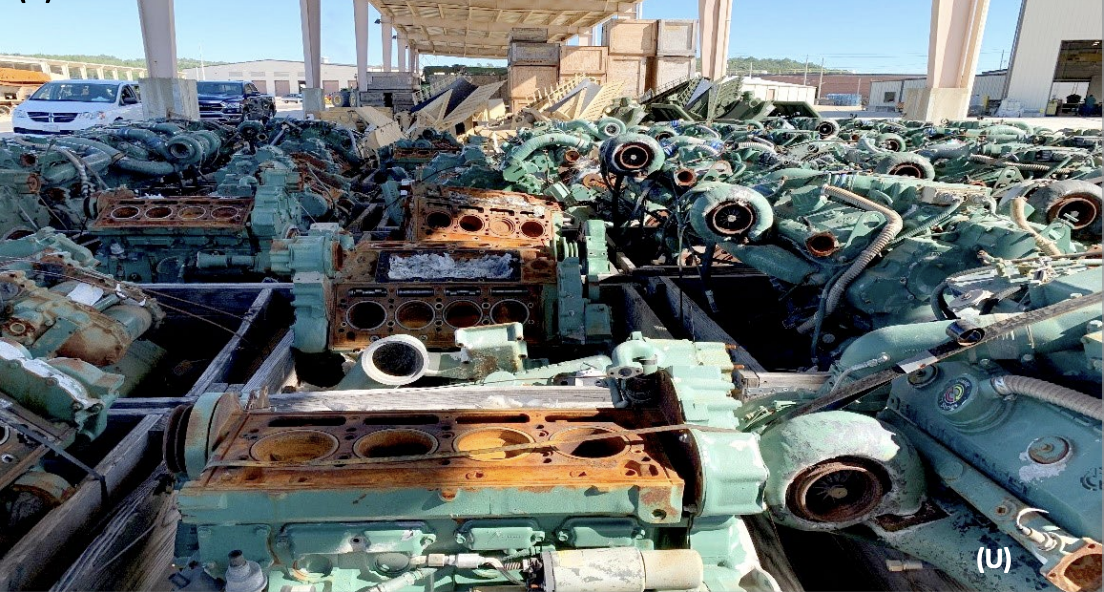

A lack of oversight led to the Army spending $10 million on “unnecessary repairs” for 313 engines. Elsewhere, 278 broken transmissions sit in a Department of Defense warehouse even though the Army plans to only fix 24 in a year.
A new DOD Inspector General report found billions of dollars worth of Army combat equipment was not stored or cared for properly at two major supply depots, while “unserviceable” equipment took up valuable space in warehouses. Investigators also highlighted safety concerns over carelessly stacked containers, exposed sharp metal edges and heavy equipment held in place by loose straps.
An audit of the Defense Logistics Agency found that billions of dollars worth of Army ground combat systems and spare parts — from truck engines to range finders to tank treads — were deteriorating or at increased risk of deterioration due to improper storage and care.
“The continued improper storage and care of GCS items may result in increased restoration or replacement costs, which would require additional funding and time, and negatively impact operational readiness,” according to the report.
Subscribe to Task & Purpose Today. Get the latest military news and culture in your inbox daily.
The audit looked at the Army’s inventory of GCS equipment, which is the machines and spare parts that soldiers use for movement, protection and firepower on the battlefield. The audit included the Stryker Armored Combat Vehicle and Abrams Tank, and repair parts and components include tank engines, transmissions, vehicular track shoes, rubber wheels and electrical components.
In all, the report examined 93% of the Army’s ground combat spare parts and components stored in two DLA centers. The two centers store 2.17 million individual GCS repair parts and components valued at $3.87 billion, as of July 7, 2022.
Of that $3.87 billion in parts, the IG found $1.31 billion worth had “critical” deficiencies, meaning the equipment was deteriorating and in “immediate danger” of being unuseable. Another $200.22 million worth of parts had “major” deficiencies and $192 million had “minor” deficiencies.
Inspectors found that gas turbines were stored with excessive humidity levels, transmission assemblies were stored without packaging and some equipment rusted from being stored outside — all of which, the report found, will now or will eventually cost tens of millions to fix or replace. Much of the Army’s items reviewed by inspectors had damaged packaging, were missing hardware, had improper seals or stored in less than protective containers, according to the report.
The report also found that Army materiel managers did not dispose of “unserviceable equipment” — meaning gear that was broken or unusable — which took up “limited storage space.” In one case, inspectors took pictures of dozens of corroded diesel engines in outdoor storage. Shown the pictures, a DLA official said they were unsure if the engines could ever be repaired.
But even when equipment was unserviceable, inspectors found, they were still given routine, but now “unnecessary,” inspections. Workers at the facilities, the report found, “gave the same priority to inspecting excess unserviceable materiel stored outdoors as they do for more valuable engines and transmissions.”
The Army prescribes storage requirements and the DLA is responsible for carrying out the storage methods that meet those requirements. The report found that the DLA did not have adequate guidance and training and the Army did not adequately oversee its materiel in DLA facilities.
The IG found that DLA distribution centers did not have formal training for receiving, packaging, storing or inspecting materiel. The report recommended that the DLA director implement a formal routine and training program or at the very least, make sure their personnel understand proper packaging and labeling, remediation procedures and storage guidelines.
Several of the IG’s improvement suggestions were not addressed by DLA in its initial response to the report’s findings. This includes recommendations to: categorize identified care of supplies in storage deficiencies as critical, major and minor; request storage and packaging deviations from materiel manager; and stack and space materiel to facilitate care of supplies in storage inspections and remediations.
The latest on Task & Purpose
- Navy fires captain of guided-missile cruiser USS Lake Erie
- The M10 Booker Combat Vehicle is definitely a tank, says Gen. Abrams
- Why Navy SEALs wear a trident and other facts about life as a frogman
- A-10 Warthogs arrive, more U.S. forces coming amid Israel-Gaza fighting
- Army plans to cut ‘unnecessary maintenance’ on vehicles and weapons